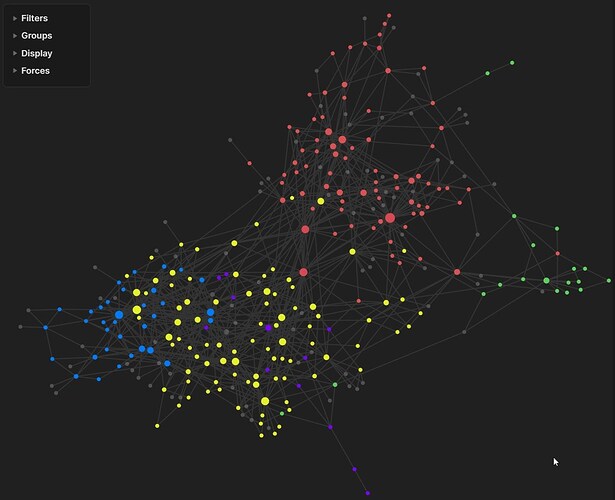I’ve been studying a quantitative master’s degree in the last few months and all my notes are in Obsidian, even lots of LaTeX equations. I have a few hundred notes and the graph view has been incredibly useful for me to understand concepts on my course. I’m pleased with results I’ve had from my recent assessments so it’s gone well; if I did ‘linear’ notes I wouldn’t have done that well.
Two of the biggest modules of my degree have been biostats ( ) and epidemiology (
) and epidemiology ( ). Over time it really became clear when I was taking notes how they related to each other, from the graph view. I have one folder per module in my vault and use those for the colour code.
). Over time it really became clear when I was taking notes how they related to each other, from the graph view. I have one folder per module in my vault and use those for the colour code.
My longest notes have ~1k words. The typical note has ~250 words. My knowledge base currently totals over 55k words. I wasn’t expecting to write so much…  I initially thought it would be very tough to revise that amount of content, but didn’t need to read much for exam preparation. The note taking process definitely helped my comprehension of concepts.
I initially thought it would be very tough to revise that amount of content, but didn’t need to read much for exam preparation. The note taking process definitely helped my comprehension of concepts.
Backlinks are the most powerful thing IMO (not the main graph view), especially when you have dozens of notes. Backlinks are what I used most for navigating between concepts and understanding how things relate to each other, in a rapid way. If a note didn’t have the backlinks that I’d have expected, it was a sign I needed to revisit other notes and add wikilinks to that note.
General summary of how I have done note-taking:
- I do one note per concept. If something sounds like a concept that may come up, I’ll create a wikilink for it. I haven’t felt need to make notes for literature.
-
I don’t do MOCs. I wouldn’t even know how to structure MOCs for my knowledge graph!
 The closest thing I have is a few notes that have many wikilinks, e.g. ‘Study designs’ note has a table of the different study designs in epidemiology, ‘Hypothesis testing’ note has sections for different types of tests e.g. goodness of fit, tests of independence. I created those notes to help synthesise the concepts - they aren’t really tables of content, they do have a fair amount of text.
The closest thing I have is a few notes that have many wikilinks, e.g. ‘Study designs’ note has a table of the different study designs in epidemiology, ‘Hypothesis testing’ note has sections for different types of tests e.g. goodness of fit, tests of independence. I created those notes to help synthesise the concepts - they aren’t really tables of content, they do have a fair amount of text. - If a note has many sections or gets quite large (~750 words), that is an indication I could benefit from splitting out the content into more notes. I have a note for ‘Bias’, which is around 750 words and is focused on the statistical aspects of bias, but early on it also had content on types of bias that affect study design (e.g. ‘Selection bias’). Once I had more detail on those concepts in later lectures, I would rework the notes. It ended up quite organic.
- I do tagging to help me flag which notes I need to rework, where I need to spend more time writing compared to what I managed during lectures. Typically it would be something like ‘#REVISIT’ - I would blast through about 30 of these on a good day. It was actually quite a nice way to gamify my learning. I now have about ~60 of these tags in my graph so I figure I need around 3 solid days of reworking my notes before my next term starts.
- I tend to keep code blocks and equations in notes for concepts. I don’t split it out into separate notes for equations, libraries, etc.
I’m doing modules next term on the machine learning, I can see from the greyed out notes where some of the concepts fit in my current graph, so that also gives me ideas of which notes I should revise ahead of that.
